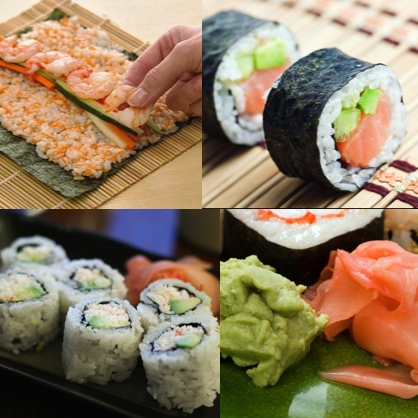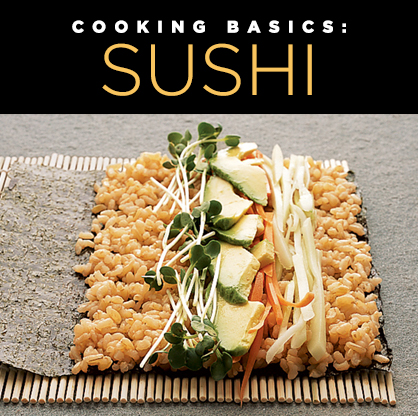Cooking Basics: Making Sushi
This week, we tackle sushi. From the rolling mat to the finishing touches of wasabi and pickled ginger, here is how to make the popular Japanese food right from your own home. Learn the basics of sushi making, down to the right rice and the perfect fillings.
THE MAT
Although you can do without one, a sushi mat, known as a makisu, is a good idea. Woven of bamboo and cotton string, a mat can keep an even pressure from all sides of your sushi roll as you roll it up. Skip the cheap version, which has rounded sides on both sides of the mat, in favor of a mat with one rounded side and one flat side – it will yield better results. If you are making a roll with rice on the outside, cover your makisu with plastic film first. Be sure to wash your mat by hand with a special brush to reach the rice stuck between the slats and let air dry. The mat can also do double duty to squeeze water out of foods.
NORI: THE WRAP
Responsible for holding the sushi together, nori is a paperlike pressed sheet of toasted seaweed. The seaweed is harvested, washed, shredded and then pressed and roasted to make the sheets we call nori.
With its unique seaweed flavor, the dark green sheets are created from a type of red algae. Available in packs of 10s or 50s, it is crucial to keep it extremely dry until use. Once it touches the moist rice, the seaweed turns sticky, serving as a skin for the sushi roll. Full of fiber, minerals and vitamins, nori can also be used shredded or in mixtures of other dishes.
THE RICE
Proper sushi making requires a certain type of rice, known as sushi-meshi or shari. Using long-grain, basmati, jasmine or other rice varieties will not work. Sushi rice, a short-grained rice, is perfect for sushi because of its stickiness. It is washed, cooked and seasoned with rice vinegar, sugar and salt before used, in a procedure that may take a little time to master. First you rinse the rice two to three times, then boil, cover and cook. After letting it set for 10 minutes, add the warmed up vinegar, sugar and salt and toss to coat. Let cool before starting your sushi making.

THE FILLINGS
The good part about making your own sushi at home is you get to fill it with whatever you like. In the U.S., with modern fusion cuisines, a number of more unusual ingredients have become popular, such as cream cheese, kimchi and fruits like plum and strawberry. Although not required, raw seafood remains the mainstay, with other ingredients there to complement its flavor. Other common ingredients include shrimp, squid, octopus, eel, clams and roe, or fresh fish eggs. One of the most famed sushi dishes, the California roll, is an inside-out roll stuffed with crab, avocado and cucumber. Simple, yet delicious!
THE SIDES: WASABI/GINGER/SOY SAUCE
Once you have your sushi sliced up, it is time to add the condiments.
- Shoyu is the preferred soy sauce for dipping. The primary condiment, shoyu is made from fermented soybeans, wheat and salt aged together in a vat. Sushi bars typically go for a thinner, lighter variety of soy sauce so as to not overpower the more subtle flavors of the roll.
- Pickled ginger, known as gari, is designed to cleanse the palate between different types of sushi. Its antimicrobial nature is thought to prevent sickness from contamination. Gari is made from fresh, young ginger paired with salt, sugar and rice vinegar.
- Wasabi, a spicy green cousin of horseradish from the cabbage family, is formed into a paste and eaten right before the sushi for some kick. The paste comes from the plant’s rhizome, which is harvested and then ground fresh to maximize the flavor.
Tagged in: food, recipes, kitchen, cooking basics,

LadyLUX via Gourmet.com



